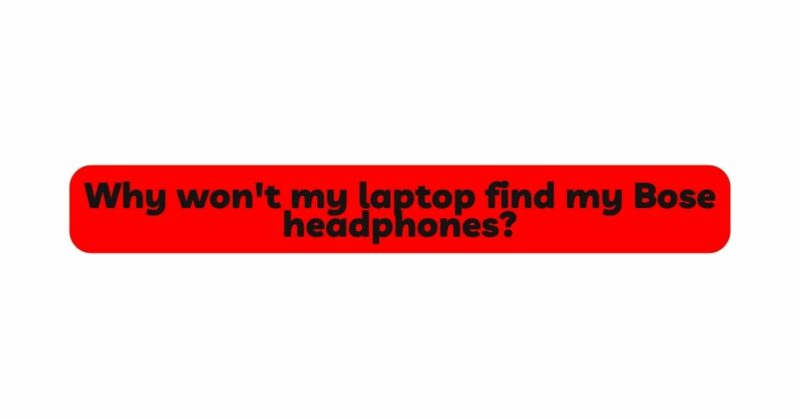In the fast-paced digital age, the convenience of wireless audio devices, such as Bluetooth headphones, has become a staple for many tech-savvy individuals. Among the popular brands offering exceptional sound quality and comfort is Bose. However, despite the advancements in technology, users may encounter connectivity issues, leaving them frustrated when their laptop fails to find their Bose headphones. If you find yourself in this predicament, fear not! In this comprehensive troubleshooting guide, we will delve into the possible reasons why your laptop is unable to detect your Bose headphones and explore various solutions to overcome this obstacle.
I. Understanding Bluetooth Connectivity
Before diving into the troubleshooting process, it is crucial to grasp the basics of Bluetooth connectivity. Bluetooth is a wireless communication technology that allows devices to establish short-range connections and exchange data seamlessly. To use your Bose headphones with your laptop, both devices must support Bluetooth technology.
When your laptop searches for nearby Bluetooth devices, it is essentially scanning for devices that are in “discoverable” mode. In this mode, your Bose headphones actively broadcast their presence, making them visible and available for pairing. If your laptop fails to find your Bose headphones, it could be due to a combination of hardware, software, or user-related issues. Let’s explore the potential reasons and solutions.
II. Hardware-Related Issues
- Check Bluetooth Compatibility: The first step is to ensure that both your laptop and Bose headphones support Bluetooth technology and are compatible with each other. Check the user manuals or the manufacturer’s website for the supported Bluetooth versions and device compatibility.
- Verify Bluetooth Is Turned On: Ensure that the Bluetooth feature is enabled on your laptop. Typically, laptops have a physical switch or a keyboard shortcut (e.g., Fn + F3) to toggle Bluetooth on and off. Alternatively, you can access the Bluetooth settings through the Control Panel or the Action Center on Windows laptops and the System Preferences on macOS.
- Check Battery Levels: Low battery levels on your Bose headphones might hinder their visibility to other devices. Charge your headphones to an adequate level and try the pairing process again.
- Restart Devices: Sometimes, a simple restart can resolve connectivity issues. Turn off both your laptop and Bose headphones, then power them back on and attempt pairing again.
III. Software-Related Issues
- Update Bluetooth Drivers: Outdated or corrupted Bluetooth drivers can lead to connectivity problems. Visit the laptop manufacturer’s website or use the Device Manager on Windows (or System Information on macOS) to check for driver updates. Download and install any available updates to ensure optimal Bluetooth functionality.
- Clear Paired Devices List: Over time, your laptop’s list of paired devices may become cluttered, leading to confusion when attempting to connect to your Bose headphones. Remove any old or unused entries from the paired devices list and try pairing again.
- Troubleshoot Bluetooth Services: On Windows, if you encounter Bluetooth connection issues, use the built-in troubleshooter to identify and resolve common problems. Right-click the Bluetooth icon in the system tray, select “Troubleshoot,” and follow the on-screen instructions.
- Reset Bluetooth Module: If your laptop has a separate Bluetooth module, resetting it may help resolve connectivity issues. Refer to the manufacturer’s documentation on how to reset the Bluetooth module properly.
IV. User-Related Issues
- Activate Discoverable Mode on Bose Headphones: To be detected by your laptop, your Bose headphones need to be in discoverable mode. Refer to your headphone’s user manual to learn how to activate this mode, as it may vary depending on the model.
- Pairing Procedure: Ensure you are following the correct pairing procedure. Typically, this involves putting your Bose headphones in discoverable mode and then initiating the pairing process on your laptop. Double-check both device’s instructions for the precise steps.
- Bluetooth Interference: Bluetooth signals can be impacted by other wireless devices or obstacles. Keep your laptop and Bose headphones in close proximity to reduce interference, and avoid using them in crowded places with numerous Bluetooth devices.
- Remove Signal Blockers: Certain objects, like metal surfaces or electronic devices, can obstruct Bluetooth signals. Place your laptop and headphones in an open space to improve signal reception.
Conclusion
Bluetooth connectivity issues between your laptop and Bose headphones can be frustrating, but they are not insurmountable. By understanding the fundamentals of Bluetooth technology and employing the troubleshooting steps outlined in this guide, you can increase the likelihood of successful pairing. Always ensure both devices are compatible, maintain updated drivers and firmware, and follow proper pairing procedures.
In the end, patience and persistence are key. If the problem persists despite your best efforts, consider reaching out to Bose’s customer support or your laptop manufacturer for further assistance. Embrace the wireless audio experience with your Bose headphones, as once you overcome the connectivity hurdle, you’ll undoubtedly enjoy the exceptional sound quality they have to offer.


